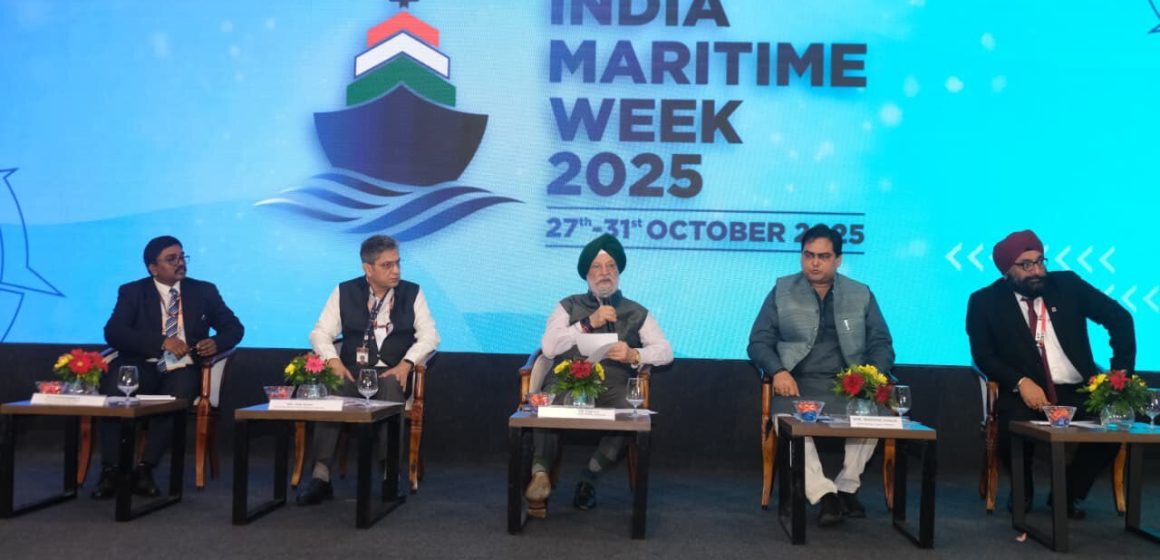India’s Oil and Gas Minister urges domestic shipbuilders and carriers to build strategic assets amid the country’s surging energy demand.
In a striking display of subtle wit, economic logic, and 39 years of diplomatic service, India’s Minister for Petroleum and Natural Gas, Hardeep Singh Puri, spotlighted the massive growth opportunity for domestic shipbuilders and shipping companies amid India’s surging energy demand.
Speaking at the ongoing India Maritime Week—the world’s largest maritime forum—in Mumbai on Wednesday morning, Puri said, “The International Energy Agency had forecast that in the coming two decades, 25 per cent of the increase in global energy demand will come from India. I was attending a meeting in Hyderabad yesterday, and when I saw my speaking notes and cross-checked those figures, they said 30 per cent of the global increase will come from India!”
Addressing the ‘Revitalising India’s Maritime Manufacturing Conference’ on day three of the global event, Puri noted that in FY2024-25, India imported around 300 million metric tonnes (MMT) of crude and petroleum products and exported around 65 MMT. The oil and gas sector alone accounted for nearly 28 per cent of India’s total trade by volume, making it the single largest commodity group at Indian ports.
He then shared a personal anecdote from his post-retirement years in New York. “Instead of paying rent for those five years, if we had acquired an apartment, the rent [today] would have been more than the mortgage payment,” he said, drawing a parallel to strategic asset creation in shipping.
Returning to sectoral specifics, Puri said, “Out of this entire trade carried by bulk carriers, only 20 per cent is transported on Indian-flagged or Indian-owned vessels. It’s a challenge now turning into an opportunity.” He cited ONGC’s projected requirement of nearly 100 offshore service and platform vessels by 2034, driven by rising demand for crude oil, LPG, LNG, and ethane.
Freight Drain
India currently meets 88 per cent of its crude and 51 per cent of its gas requirements through imports. In FY2024-25, the crude import bill crossed $150 billion, with freight charges forming a sizeable part of the landed cost.
“Our PSUs pay $5 per barrel when sourcing crude from the US and around $1.2 per barrel from the Middle East, which is roughly 10 per cent and 2 per cent of the total cost. For gas, freight averages 5 per cent from the Middle East and up to 15 per cent from the US. The case for asset creation is staring us in the face.”
He revealed that public sector oil marketing companies (OMCs), IOCL, BPCL, and HPCL spent around $8 billion on ship chartering over the last five years.
“That amount could fund a new fleet of crude oil tankers, a clear case for building long-term strategic assets. It’s an amplification of my personal story: paying rent versus acquiring through mortgage.”
Very large crude carriers (VLCCs), Suezmax, and Aframax vessels are currently used for crude imports, with about 70 ships on time charter across the three OMCs and GAIL.
“This highlights both the scale of operations and the opportunity to reduce recurring costs through ownership.”
Move In to Make in India
He outlined measures already undertaken by the government, including aggregating PSU cargo demand to ensure long-term charter viability for Indian carriers, advancing the Ship Owning and Leasing Entity (SOLE) to boost domestic ownership, and establishing a Maritime Development Fund for affordable long-tenor vessel finance. He also referred to the launch of Shipbuilding Financing Policy 2.0, which offers enhanced grants for LNG, ethane, and product tankers.
On the global shortage of vessels, Puri said the energy sector’s rising demand was colliding with full order books in major shipbuilding nations.
“The most sensible course of action is to invite them to invest and build here.”
He noted that India’s maritime sector is projected to attract ₹8 trillion in investment and generate around 1.5 crore jobs by 2047, as the country modernises ports, builds ships, promotes green shipping, and positions itself as a global maritime hub.
– Manish Pant


